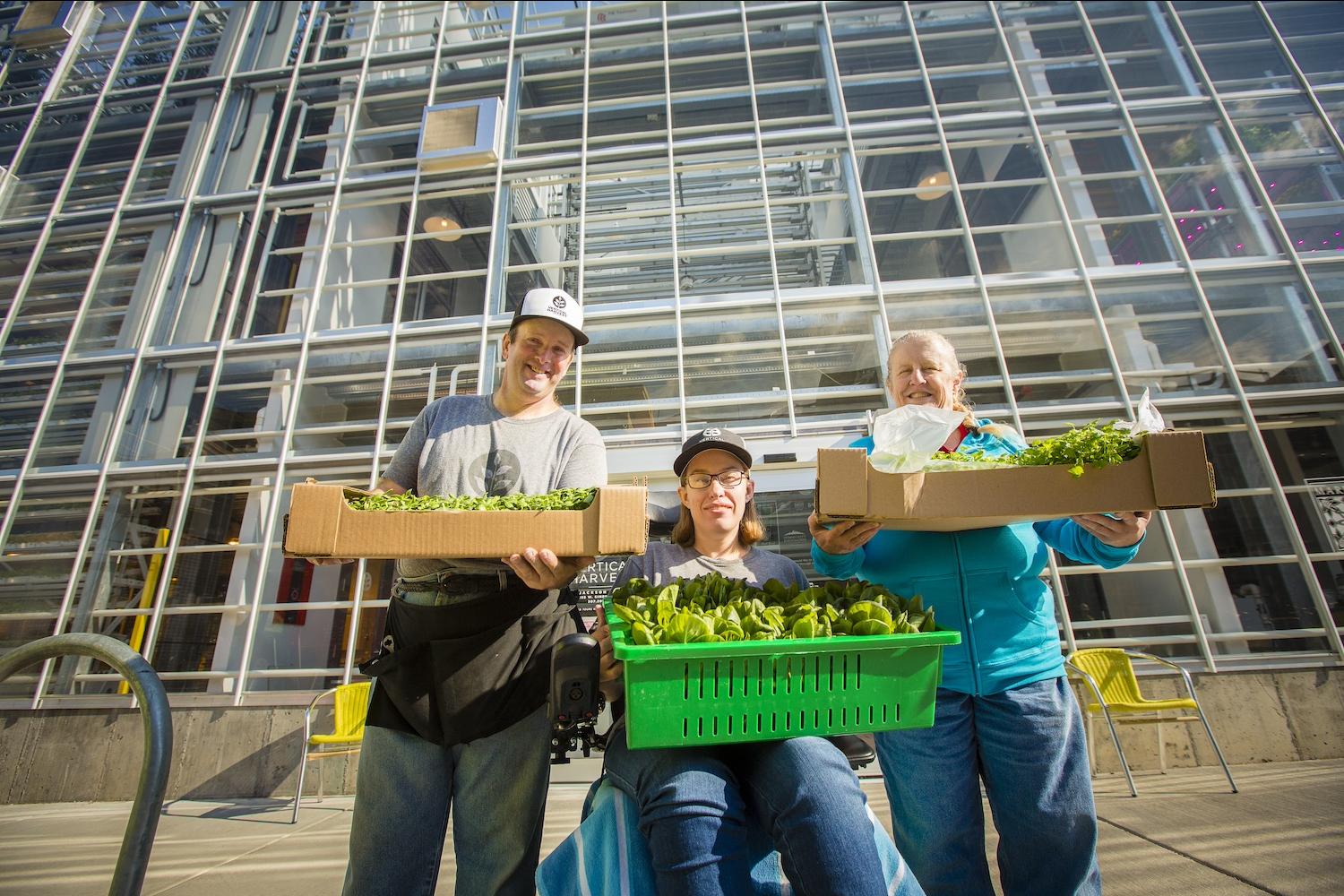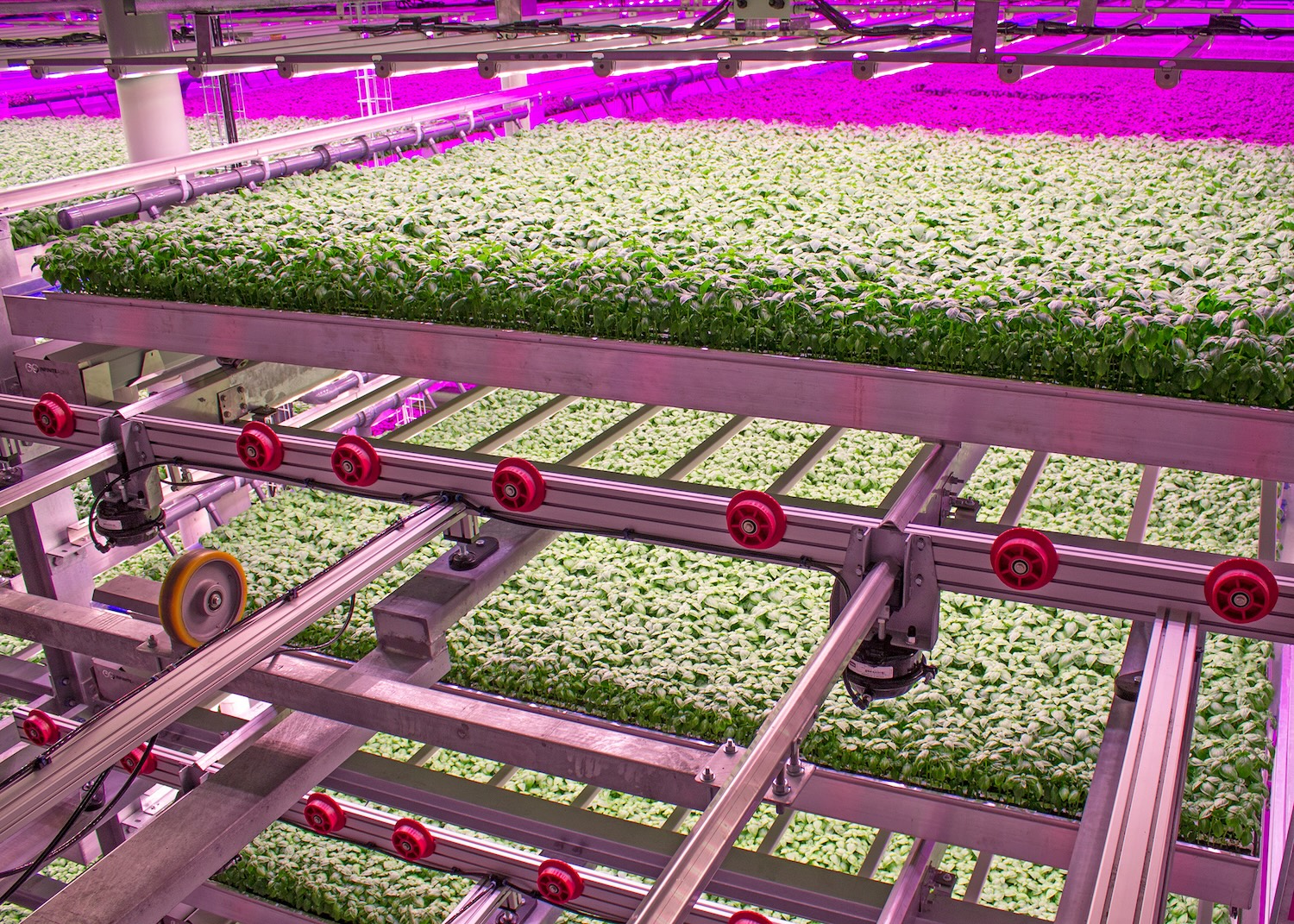
Even as some vertical farming ventures struggle, others like Vertical Harvest are still going strong. Here, microgreens grow indoors at Vertical Harvest's farm in Jackson, Wyoming. (Image: Hannah Hardaway Photography, courtesy of Vertical Harvest)
Vertical farming isn't easy, with startup and energy costs among the factors leading some high-profile vertical farming companies to collapse or scale back over recent years. But the pressures of climate change and water scarcity continue to keep interest in the field alive, alongside the rising consumer demand for freshly harvested, pesticide-free produce that's grown locally.
Why vertical farms fail
Indoor vertical farms make sense for a lot of reasons. Farming in-demand produce like leafy greens and berries indoors all year round reduces the need to transport food over long distances. The controlled environment of vertical farms also allows for more food production on less land with fewer fertilizers and no need for pesticides or herbicides.
But among the tradeoffs, vertical farms use a lot of energy, and as energy grows more expensive in the U.S. and elsewhere, that's a major challenge when it comes to matching the price of produce farmed on land, even if it's shipped from out of town.
The cost challenge contributed to a number of once highly-publicized vertical farming companies filing for bankruptcy, downsizing or shutting down over recent years — including AeroFarms, Bowery Farming, Plenty and AppHarvest.
Where vertical farms are set up can also be a key predictor of success, as illustrated by the slow, stuttering growth of the $500 million Sensei Ag venture. With the backing of Oracle co-founder and billionaire Larry Ellison, Sensei Ag launched in 2020 on a mission to transform the global agriculture industry through new artificial intelligence and robotic technologies across a variety of platforms including vertical farming.
Unfortunately, Ellison and his partners chose his personal Hawaiian island, Lāna’I, as the site of the new Sensei Farms venture. As The Wall Street Journal reported earlier this year, the promise of an eco-friendly revolution in agricultural technology soon fell apart under the strong winds of Hawaii, which blew the roofs off greenhouses several times and upended plans for using solar power, forcing the operation to rely on diesel generators much of the time.
Ellison also failed to account for the weakness of wireless internet connections on his island, which he had purchased in 2012. “Wi-Fi problems meant cameras and high-tech sensors, which were supposed to monitor the crops’ health and control such things as window shades, also didn’t operate as planned,” The Wall Street Journal reported.
Finance Monthly was among other news organizations to analyze the long, expensive learning curve at work at Sensei Ag. “Local expertise, smarter planning, and collaboration with experienced agricultural professionals may be the key to making Sensei Farms a success in the long run,” the publication concluded.

A more strategic model for vertical farms
Weather and Wi-Fi weren't the only factors that made Sensei Farms' location less than ideal. The outdoor growing season in Hawaii lasts practically all year, which neutralized one of the key advantages of indoor farms. Ventures like Plenty, based in Southern California, faced similar problems.
But other vertical farm ventures in the U.S. are thriving under a more sustainable site selection model and a more judicious deployment of technology. In May, for example, the trade publication Robotics and Automation News posted its list of top 20 success stories in the U.S. and elsewhere, including the Wyoming-based company Vertical Harvest.
Vertical Harvest has gained attention for a focus on worker training and retention, helping to keep costs down during its eight years in business. Site selection is also an important factor in the company’s success. The Wyoming growing season lasts only four months, while Vertical Farms can provide local residents with freshly harvested produce year-round.
Site selection of a different sort is at work at 80 Acres Farms, another U.S. firm listed by Robotics and Automation. The company prioritized access to renewable energy for its large-scale operations in Ohio and Kentucky, helping to reduce energy costs. It's also looking to expand with an eye toward the opportunities in existing but underutilized vertical farm infrastructure.
“National retailers and foodservice distributors are seeking partners that can consistently supply high-quality product through a national network of local farms,” 80 Acres CEO and co-founder Mike Zelkind said in a statement earlier this year when the company acquired three existing vertical farms in Georgia, Texas and Colorado. 80 Acres plans to upgrade the three farms through a technology platform developed by its Dutch-Israeli-American subsidiary, Infinite Acres.

The vertical movement continues to grow
As indicated by the Infinite Acres venture, 80 Acres has made substantial investments in research and development to support its business model. That includes a research center in Arkansas, where 80 Acres has worked with scientists from the University of Arkansas on vertical farming research since 2021.
In another indication that the vertical farming sector still holds promise, Illinois State University officially opened its new Vertical Farm program in May, aimed at training students for specialty crop careers. The farm, housed in a repurposed shipping container, is also designed as a learning tool for community organizations and entrepreneurs.
The single shipping container has a capacity of 4,600 plants, equivalent to one or two acres of open-air field production, according to Illinois State. The vertical farm also needs only about 5 gallons of water daily, 95 percent less water than would be required on an open field. No pesticides are needed in the closed environment, and the use of chemical fertilizers is limited.
The abrupt shift in federal policy notwithstanding, market analysts anticipate the U.S. vertical farming market will continue to grow. In a report published this week, for example, the firm Insightace Analytics cites water scarcity, drought and environmental awareness among the factors continuing to support the future growth of vertical farming in the U.S.
Globally, Insightace also takes note of urbanization and the rising demand for food. “Vertical farming systems, particularly those employing hydroponic greenhouses, facilitate continuous crop production throughout the year-potentially achieving up to 11 to 13 harvests annually — thereby addressing food security challenges in densely populated urban regions,” the report reads.
The path for growth is clear, with less focus on changing the world, and more focus on location, markets, employees, and other foundational elements of a successful and sustainable business.

Tina writes frequently for TriplePundit and other websites, with a focus on military, government and corporate sustainability, clean tech research and emerging energy technologies. She is a former Deputy Director of Public Affairs of the New York City Department of Environmental Protection, and author of books and articles on recycling and other conservation themes.














